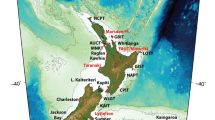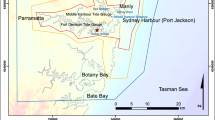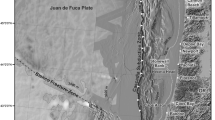Abstract
We assess tsunami hazards in San Diego Bay, California, using newly identified offshore tsunami sources and recently available high resolution bathymetric/topographic data. Using MOST (Titov and Synolakis, J Waterways Port Coastal Ocean Eng ASCE 124(4):57–171, 1998), we simulate locally, regionally and distant-generated tsunamis. Local tsunami source models use more realistic fault and landslide data than previous efforts. With the exception of the Alaska-Aleutian Trench, modeling results suggest that local sources are responsible for the largest waves within the San Diego Bay and Mission Bay. Because San Diego Bay is relatively well protected by North Island and the Silver Strand, the wave heights predicted are consistently smaller inside the harbor than outside. However, historical accounts, recent tsunamis and our predictions show that San Diego Bay is vulnerable to strong tsunami induced currents. More specifically, large currents are expected inside the harbor for various distant and local tsunami sources with estimated flow velocities exceeding 100 cm/s. Such currents have been damaging to harbor facilities, such as wharves and piers, and may cause boats to break from moorings and ram into adjacent harbor structures, as observed in recent historic tsunamis. More recently, following the M w 8.8 February 27, 2010 Chile earthquake, tsunami-currents damaged docks/piers in Shelter Island confirming our findings. We note that the first generation of inundation maps in use in San Diego County by emergency management was based on much larger “worst case but realistic scenarios” (Synolakis et al. 2002a), which reflected the understanding of offshore hazards pervasive ten years ago. Large inundation and overland flow depths were observed primarily in local tsunami source simulations. In particular, locally induced tsunamis appear capable to overtop the Silver Strand. The results suggest that further work needs to be carried out with respect to local tsunami sources as they seem to have worse impact in the San Diego region than previously thought but probably low probability of occurrence. We also predict that a coastal community can be devastated simultaneously by large waves inundating shores and large currents in locations with small flow depths.






Similar content being viewed by others
References
Agnew DC (1979) Tsunami history of San Diego. In: Abbott PL, Elliott WJ (eds) Earthquakes and other perils—San Diego region. San Diego Association of Geologists Guidebook, San Diego, pp 117–122
Anderson JG, Rockwell TK, Agnew DC (1989) Past and possible future earthquakes of significance to the San Diego region. Earthquake Spectra 5(2):289–335
Astiz L, Shearer PM (2000) Earthquake locations in the inner Continental Borderland, offshore southern California. Bull Seism Soc Am 90:425–449
Bohannon RG, Geist E (1998) Upper crustal structure and Neogene tectonic development of the California Continental Borderland. Geol Soc Am Bull 110:779–800
Borrero J, Cho S, Moore J, Richardson HW, Synolakis CE (2005) Could it happen here? Civil Eng 75(4):54–65, 133
Borrero JC, Dolan JF, Synolakis CE (2001) Tsunamis within the east Santa Barbara channel. Geophys Res Lett 28:643–646
Borrero JC, Legg MR, Synolakis CE (2004) Tsunami sources in the Southern California Bight. Geophys Res Lett 31:L13211
Borrero J, Ortiz M, Titov V, Synolakis C (1997) Field survey of Mexican tsunami produces new data, unusual photos. EOS Trans Am Geophys Union 78(8):1
Crouch JK, Suppe J (1993) Late Cenozoic tectonic evolution of the Los Angeles basin and inner California borderland: a model for core complex-like crustal extension. Geol Soc Am Bull 105:1415–1434
Davis T, Namson J, Yerkes R (1996) A cross section of the LA area: seismically active fold and thrust belt. J Geophys Res 94, No. B7 9644 9664, 1989. Models, 403 pp, World Scientific, New Jersey
Dengler L, Uslu B (2011) Effects of harbor modification on Crescent City, Californias tsunami vulnerability. Pure and Applied Geophysics in topical issue. Tsunamis in the world ocean: past, present and future, in press
Dengler L, Uslu B, Barberopoulou A, Yim SC, Kelley A (2009) Tsunami damage in Crescent City, California from the November 15, 2006 Kuril event. Pure Appl Geophys (Pageoph) 166(1)
Dolan JF, Sieh K, Rockwell TK, Yeats RS, Shaw J, Suppe J, Huftile G, Gath E (1995) Prospects for larger or more frequent earthquakes in greater metropolitan Los Angeles, California. Science 267:199–205
Dolan JF, Sieh KE, Rockwell TK (2000) Late Quaternary activity and seismic potential of the Santa Monica fault system, Los Angeles, California. Geol Soc Am Bull 112:1559–1581
Fischer PJ, Mills GI (1991) The offshore Newport-Inglewood—Rose Canyon fault zone, California: structure, segmentation, and tectonics. In: Abbott PL, Elliott WJ (eds) Environmental perils of the San Diego region. SanDiego Association of Geologists Guidebook, San Diego, pp 17–36
Frankel AD, Petersen MD, Mueller CS, Haller KM, Wheeler RL, Leyendecker EV, Wesson RL, Harmsen SC, Cramer CH, Perkins DM, Rukstales KS (2002) Documentation for the 2002 update of the national seismic hazard maps, open file report 03-420, U.S. Geological Survey, U.S. Department of the Interior, Denver, CO
Francis RD, Legg MR (2007) Late Quaternary uplift of the Palos Verdes tectonic block; evidence from high-resolution seismic imaging of the Palos Verdes fault on the San Pedro shelf. In: Brown AR, Shlemon RJ, Cooper JD (eds) Geology and paleontology of Palos Verdes Hills, California. Pacific Section SEPM Book 103, Fullerton, CA, pp 189–222
Goldfinger C, Legg MR, Torres ME (2000) New mapping and submersible observations of recent activity on the San Clemente Fault, AGU 2000 fall meeting, EOS Trans Am Geophys Union 81(48):1069
Hauksson E, Jones LM (1988) The July 1986 Oceanside (ML=5.3) earthquake sequence in the Continental Borderland, southern California. Seism Soc Am Bull 78:1885–1906
Hauksson E (1987) Seismotectonics of the Newport-Inglewood fault zone in the Los Angeles basin, southern California. Bull Seism Soc Am 77:539–561
Imamura F, Synolakis CE, Gica E et al (1995) Field survey of the 1994 Mindoro Island, Philippines tsunami, tsunamis; 1992–1994, their generation, dynamics, and hazard. Pure Appl Geophys 144(3–4):875–890
Kennedy MP, Clarke SH, Greene HG, Legg MR (1980) Recency and character of faulting offshore metropolitan San Diego, California: California Division of Mines and Geology, map sheet 42, Scale 1:50,000
Kennedy MP, Welday EE (1980) Recency and character of faulting offshore metropolitan San Diego, California (area 1 of 3, San Diego Bay and immediate offshore shelf): California Division of Mines and Geology map sheet 40, Scale 1:50,000
Lander JF, Lockridge PA, Kozuch MJ (1993) Tsunamis affecting the west coast of the United States 1806–1992, NGDC key to geophysical record documentation no. 29, NOAA, NESDIS, NGDC, 242 pp
Legg M, Agnew DC (1979) The 1862 earthquake in San Diego. In: Earthquakes and other perils in San Diego region. SanDiego Association of Geologists, San Diego, CA, pp 139–141
Legg MR (1985) Geologic structure and tectonics of the inner Continental Borderland offshore northern Baja California, Mexico. unpublished Ph.D. dissertation, University of California, Santa Barbara, Santa Barbara, CA, 410 p
Legg MR, Kennedy MP (1991) Oblique divergence and convergence in the California Continental Borderland. In: Abbott PL, Elliott DC (eds) Environmental perils of the San Diego region. SanDiego Association of Geologists Guidebook, SanDiego, pp 1–16
Legg MR (1991) Developments in understanding the tectonic evolution of the California Continental Borderland. In: Osborne RH (ed) From shoreline to abyss. Society of Economic Paleontologists and Mineralogists (SEPM), Special publication 46, pp 291–312
Legg MR, Luyendyk BP, Mammerickx J, De Moustier C, Tyce RC (1989) Sea Beam survey of an active strike-slip fault—the San Clemente fault in the California Continental Borderland. J Geophys Res 94:1727–1744
Legg MR, Borrero JC (2001) Tsunami potential of major restraining bends along submarine strike-slip faults. In: Proceedings of the International Tsunami Symposium 2001, NOAA/PMEL, Seattle, WA, pp 331–342
Legg MR, Goldfinger C (2002) Earthquake potential of major faults offshore southern California: collaborative research with Oregon State University and Legg Geophysical. Final technical report, U.S. Geological Survey Grant No. 01HQGR0017, 24 p
Legg MR, Kamerling MJ (2003) Large-scale basement-involved landslides, California Continental Borderland. Pure Appl Geophys 160(10–11):2033–2051. doi:10.1007/s00024-003-2418-9
Legg MR, Borrero JC, Synolakis CE (2004) Tsunami hazards associated with the Catalina fault in southern California. Earthq Spectra 20:917–950
Legg MR, Goldfinger C, Kamerling MJ, Chaytor JD, Einstein DE (2007) Morphology, structure and evolution of California Continental Borderland restraining bends. In: Cunningham WD, Mann P (eds) Tectonics of strike-slip restraining and releasing bends in continental and oceanic settings. Geological Society of London Special Publications, London, vol 290, pp 143–168
Magistrale H (1993) Seismicity of the Rose Canyon fault zone near San Diego, California. Bull Seism Soc Am 83(6):1971–1978
McNeilan TW, Rockwell TK, Resnick GS (1996) Style and rate of Holocene slip, Palos Verdes fault, southern California. J Geophys Res 101(B4):8317–8334
Nardin TR, Henyey TL (1978) Pliocene-Pleistocene diastrophism of the Santa Monica and San Pedro shelves, California Continental Borderland. Am Assoc Pet Geol Bull 62:247–272
Ozturk H, Koral H (2000) Intra-basinal water movements induced by faulting; the August 17, 1999, Golcuk (Izmit Bay) earthquake (M w = 7.4). Mar Geol 170(3–4):263–270
Pacheco J, Nabelek J (1988) Source mechanisms of three moderate California earthquakes of July, 1986. Seism Soc Am Bull 78:1907–1929
Rivero C, Shaw JH, Mueller K (2000) Oceanside and Thirtymile Bank blind thrusts: implications for earthquake hazards in coastal southern California. Geology 28:891–894
Ryan HF, Legg MR, Conrad JE, Sliter RW (2009) Recent faulting in the Gulf of Santa Catalina: San Diego to Dana Point. In: Lee HJ, Normark WR (eds) Earth science in the urban ocean: The Southern California Continental Borderland: Geological Society of America Special Paper, vol 454, pp 291–315, doi:10.1130/2009.2454(4.2)
Sorlien CC (1999) Rapid subsidence and south propagation of the active Santa Monica Mountains-Channel Islands thrust: annual report Southern California Earthquake Center, v. Available on the Internet at: http://www.scec.org/research/99research/, 5 p
Shaw J, Suppe J (1994) Active faulting and growth folding in the eastern Santa Barbara Channel, California. Geol Soc Am 106:607–626
Smith WST (1898) A geological sketch of San Clemente Island: U.S. Geological Survey, 18th annual report, part 2, pp 465–496
Stierman D, Ellsworth W (1976) Aftershocks of the February 21, 1973 Point Mugu, California earthquake. Bull Seism Soc Am 66(6):1931–1952
Synolakis CE, Borrero JC, Eisner R (2002a) Developing inundation maps for southern California. In: Proceedings of the 2002 coastal disasters conference. Am Soc Civ Eng Conf Proc 258:848–862
Synolakis CE, Bardet JP, Borrero J, Davies H, Okal E, Silver E, Sweet J, Tappin D (2002b) Slump origin of the 1998 Papua New Guinea tsunami. Proc Roy Soc Lond A 458:763–789
Tang L, Titov VV, Chamberlin CD (2010) A tsunami forecast model for Hilo, Hawaii. NOAA OAR Special Report, PMEL Tsunami Forecast Series 1:94
Tanioka Y, Satake K (1996) Fault parameters of the 1896 Sanriku tsunami earthquake estimated from tsunami numerical modeling. Geophys Res Lett 23:1549–1552
Titov VV, Synolakis CE (1998) Numerical modeling of tidal wave runup. J Waterways Port Coastal Ocean Eng ASCE 124(4):157–171
Titov VV, Gonzalez FI (1997) Implementation and testing of the method of splitting tsunami (MOST) model, Tech Memo ERL PMEL-112, 11 pp, NOAA Pacific Marine Environmental Laboratory
Titov VV, Synolakis CE (1995) Modeling of breaking and nonbreaking long wave evolution and runup using VTCS-2. J Harbors Waterways Port Coastal Ocean Eng 121(6):308–316
Uslu B (2009) Deterministic and probabilistic tsunami studies in California. Ph.D. thesis, University of Southern California, 161 pp
Vedder JG et al (1986) Geology of the mid-southern California continental margin. In: Greene HG, Kennedy MP (eds) Geology of the California continental margin: California Division of Mines and Geology map series, sheet 1a of 7, Scale 1:250,000
Ward SN (2001) Landslide tsunami. J Geophys Res 106(6):11201–11215
Wilson RI, Dengler LA, Legg MR, Long K, Miller KM (2010) The 2010 Chilean tsunami on the California Coastline. Seism Res Lett 81(3):545–546
Author information
Authors and Affiliations
Corresponding author
Rights and permissions
About this article
Cite this article
Barberopoulou, A., Legg, M.R., Uslu, B. et al. Reassessing the tsunami risk in major ports and harbors of California I: San Diego. Nat Hazards 58, 479–496 (2011). https://doi.org/10.1007/s11069-010-9681-8
Received:
Accepted:
Published:
Issue Date:
DOI: https://doi.org/10.1007/s11069-010-9681-8




